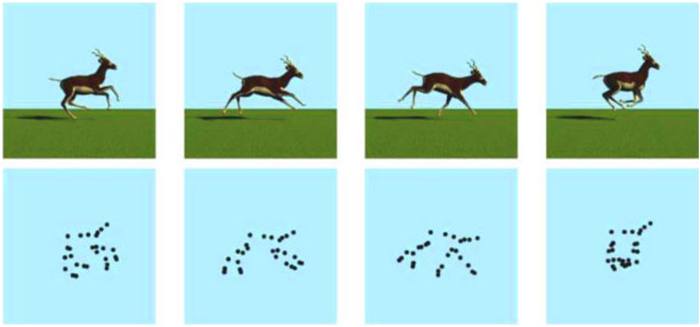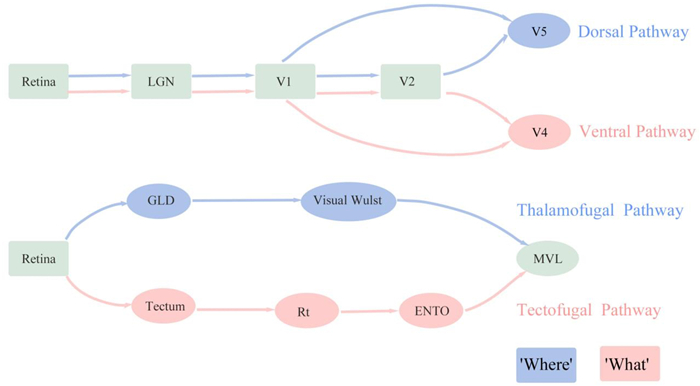
Pictures of the real animal (upper) and the corresponding outlines (lower) in different poses (Qadri and Cook, 2015). The upper shows four different movement postures of the real deer. The bottom ones present the corresponding dot-based biological-motion patterns.
Figures of the Article
-
![]() Example of bird target recognition tasks. (A) The image data set of animate objects (the upper part) and inanimate objects (the lower part; Watanabe, 1991; Azizi et al., 2019). (B) Monet's style painting (left) and Picasso's style painting (right; Anderson et al., 2020b). (C) The dataset of photos of the pigeons Bob (upper) and Larry (lower; Clark et al., 2019). (D) Different magnification of benign cell photo data set (left) and malignant tumor cell photo data set (right; Levenson et al., 2015). (E) Schematic diagram of martial arts movements (left) and Indian dance movements (right; Qadri and Cook, 2017).
Example of bird target recognition tasks. (A) The image data set of animate objects (the upper part) and inanimate objects (the lower part; Watanabe, 1991; Azizi et al., 2019). (B) Monet's style painting (left) and Picasso's style painting (right; Anderson et al., 2020b). (C) The dataset of photos of the pigeons Bob (upper) and Larry (lower; Clark et al., 2019). (D) Different magnification of benign cell photo data set (left) and malignant tumor cell photo data set (right; Levenson et al., 2015). (E) Schematic diagram of martial arts movements (left) and Indian dance movements (right; Qadri and Cook, 2017).
-
![]() Schematic diagram of the sequence structure learning task (Garlick et al., 2017). There were 8 circles arranged in a circular array on a touchscreen. During the intertrial interval, all circles are dark with their visible dim white outlines. During a trial, either two circles or all eight circles were illuminated in the 2-choice, 3-choice, and 8-choice serial multiple choices (SMC) tasks, respectively. The more circles appear, the more difficult the task is. The pigeon needs to perform the correct actions in the corresponding SMC task to obtain reward food.
Schematic diagram of the sequence structure learning task (Garlick et al., 2017). There were 8 circles arranged in a circular array on a touchscreen. During the intertrial interval, all circles are dark with their visible dim white outlines. During a trial, either two circles or all eight circles were illuminated in the 2-choice, 3-choice, and 8-choice serial multiple choices (SMC) tasks, respectively. The more circles appear, the more difficult the task is. The pigeon needs to perform the correct actions in the corresponding SMC task to obtain reward food.
-
![]() Pictures of the real animal (upper) and the corresponding outlines (lower) in different poses (Qadri and Cook, 2015). The upper shows four different movement postures of the real deer. The bottom ones present the corresponding dot-based biological-motion patterns.
Pictures of the real animal (upper) and the corresponding outlines (lower) in different poses (Qadri and Cook, 2015). The upper shows four different movement postures of the real deer. The bottom ones present the corresponding dot-based biological-motion patterns.
-
![]() Visual information flow of the two main visualpathways in pigeons and their projections to the NCL. The tectofugal pathway was marked with a red line and the thalamofugal pathway was marked with a blue line (Güntürkün et al., 2018).
Visual information flow of the two main visualpathways in pigeons and their projections to the NCL. The tectofugal pathway was marked with a red line and the thalamofugal pathway was marked with a blue line (Güntürkün et al., 2018).
-
![]() Schematic diagram of the two main visualpathways of birds (upper) and mammals (lower). The thalamofugal pathway in birds is homologous to the dorsal pathway in mammals, and can be called the "where" pathway. The tectofugal pathway of birds is homologous to the ventral pathway of mammals and can be called the "what" pathway.
Schematic diagram of the two main visualpathways of birds (upper) and mammals (lower). The thalamofugal pathway in birds is homologous to the dorsal pathway in mammals, and can be called the "where" pathway. The tectofugal pathway of birds is homologous to the ventral pathway of mammals and can be called the "what" pathway.
-
![]() An example of DMS training mode (Anderson et al., 2020a, b).
An example of DMS training mode (Anderson et al., 2020a, b).
Related articles
-
2025, 16(1): 100256. DOI: 10.1016/j.avrs.2025.100256
-
2025, 16(1): 100248. DOI: 10.1016/j.avrs.2025.100248
-
2025, 16(1): 100235. DOI: 10.1016/j.avrs.2025.100235
-
2023, 14(1): 100127. DOI: 10.1016/j.avrs.2023.100127
-
2023, 14(1): 100104. DOI: 10.1016/j.avrs.2023.100104
-
2023, 14(1): 100077. DOI: 10.1016/j.avrs.2023.100077
-
2021, 12(1): 47. DOI: 10.1186/s40657-021-00283-4
-
2021, 12(1): 18. DOI: 10.1186/s40657-021-00253-w
-
2015, 6(1): 13. DOI: 10.1186/s40657-015-0022-1
-
2012, 3(4): 295-301. DOI: 10.5122/cbirds.2012.0035


 Download:
Download:










 Email Alerts
Email Alerts RSS Feeds
RSS Feeds